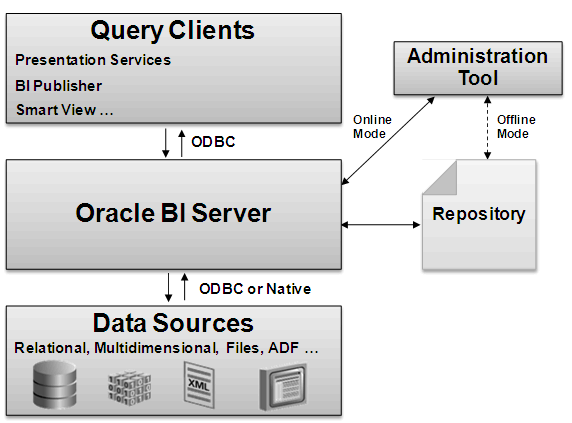About Oracle BI Server Architecture
The Oracle BI Server is an Oracle Business Intelligence component that processes user requests and queries in underlying data sources.
The Oracle BI Server maintains the logical data model and provides client access to the model using ODBC connectivity or native APIs, such as OCI for the Oracle Database.
The Oracle BI Server uses the metadata in the Oracle BI repository to perform the following two tasks:
-
Interpret Logical SQL queries and write corresponding physical queries against the appropriate data sources.
-
Transform and combine the physical result sets and perform final calculations.
The Administration Tool client is a Windows application that you can use to create and edit your Oracle BI repository. The Administration Tool can connect directly to the repository in offline mode, or it can connect to the repository through the Oracle BI Server. Some options are only available in online mode. See Using Online and Offline Repository Modes.
The image shows how the Oracle BI Server interacts with query clients, data sources, the Oracle BI repository, and the Administration Tool.
The example shows how the Oracle BI Server interprets and converts Logical SQL queries.
Logical Requests Are Transformed Into Complex Physical Queries
Assume the Oracle BI Server receives the following simple client request:
SELECT "D0 Time"."T02 Per Name Month" saw_0, "D4 Product"."P01 Product" saw_1, "F2 Units"."2-01 Billed Qty (Sum All)" saw_2 FROM "Sample Sales" ORDER BY saw_0, saw_1
The Oracle BI Server can then convert the Logical SQL query into a sophisticated physical query, as follows:
WITH SAWITH0 AS ( select T986.Per_Name_Month as c1, T879.Prod_Dsc as c2, sum(T835.Units) as c3, T879.Prod_Key as c4 from Product T879 /* A05 Product */ , Time_Mth T986 /* A08 Time Mth */ , FactsRev T835 /* A11 Revenue (Billed Time Join) */ where ( T835.Prod_Key = T879.Prod_Key and T835.Bill_Mth = T986.Row_Wid) group by T879.Prod_Dsc, T879.Prod_Key, T986.Per_Name_Month ) select SAWITH0.c1 as c1, SAWITH0.c2 as c2, SAWITH0.c3 as c3 from SAWITH0 order by c1, c2
